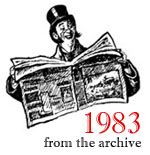
The Roman Catholic Church in Central Europe
THE POWER & THE GLORY?
The triumphant progress of the Bishop of Rome through his native Poland has made the point. Central Europe — and perhaps not central Europe alone — is entering upon a new era in which the pivotal question is no longer whether “communism” or “Christianity” will become the dominant worldview of the future. The shape of that future hinges far more on a different question — whether, in the spirit of Vatican II, the Roman Catholicism that will dominate the post-Soviet era will remain committed to the freedom with which Christ set us free, or whether, lured by the power and the glory, it will become another stifling autocracy.
That point, admittedly, has been largely lost on those observers whose conception of Roman Catholicism owes more to Ruskin’s romanticism than to historical and theological sophistication and who, much like their counterparts in the Soviet Union, continue to perceive the world situation in terms of the 1950s, as a struggle of “communism” and “anti-communism.” In such a perspective, anyone who opposes “communism” counts eo ipso as a force of freedom, much as in the days of the struggle against Nazism anyone who opposed Hitler appeared to be a force for freedom, including the (unabashedly Stalinist) Communist Parties of the time.
The Church in Soviet-ruled central Europe today stands in the vanguard of the struggle, very much the underdog. Though conditions differ — from vicious repression in Czechoslovakia through a modus vivendi in Hungary and East Germany to a very dialectical partnership in Poland — that Church, as a whole, is passing through a catacomb period. To think of it at all in terms of power and glory would take a great deal of imagination.
Imagination, though, is a mirror of memories and, in central Europe, memories run deep. These, after all, are the erstwhile Habsburg domains where, for centuries, Catholicism was identified with the Counter Reformation, the clergy were known as the “black police,” and the Church functioned as the ideological arm of a repressive, centralizing state. Though it is grievously unjust to the spirit and the service of the present-day Church, in central Europe the decades since Vatican II are measured against the centuries since the Councils of Constance and of Trent. An earlier catacomb age, that of Emperor Nero, ushered in the Constantine age which, for 11 centuries, deformed the Church of Christ with the crushing burden of the crown of Caesar. Catacombs have not typically been the training ground of tolerance. Though today every tiny, hard-won victory of the Church is a blow for freedom, generously shared, a great many thoughtful observers, including many devout Catholics, cannot quite dispel a deeper question: what kind of Catholicism will it be, in the Christian, post-Soviet era?
You May Also Enjoy
Ed. Note: Fr. Nouwen here continues the chronicle of the time he spent in Ukraine…
Love of neighbor may impel us to act like socialists, but we must not fall into the illusion that others' salvation is necessarily advanced from the charity shown them.
Catholicism in 1980s Estonia amounted to one shunned priest living in a closet; his flock numbered fewer than a half dozen souls.

